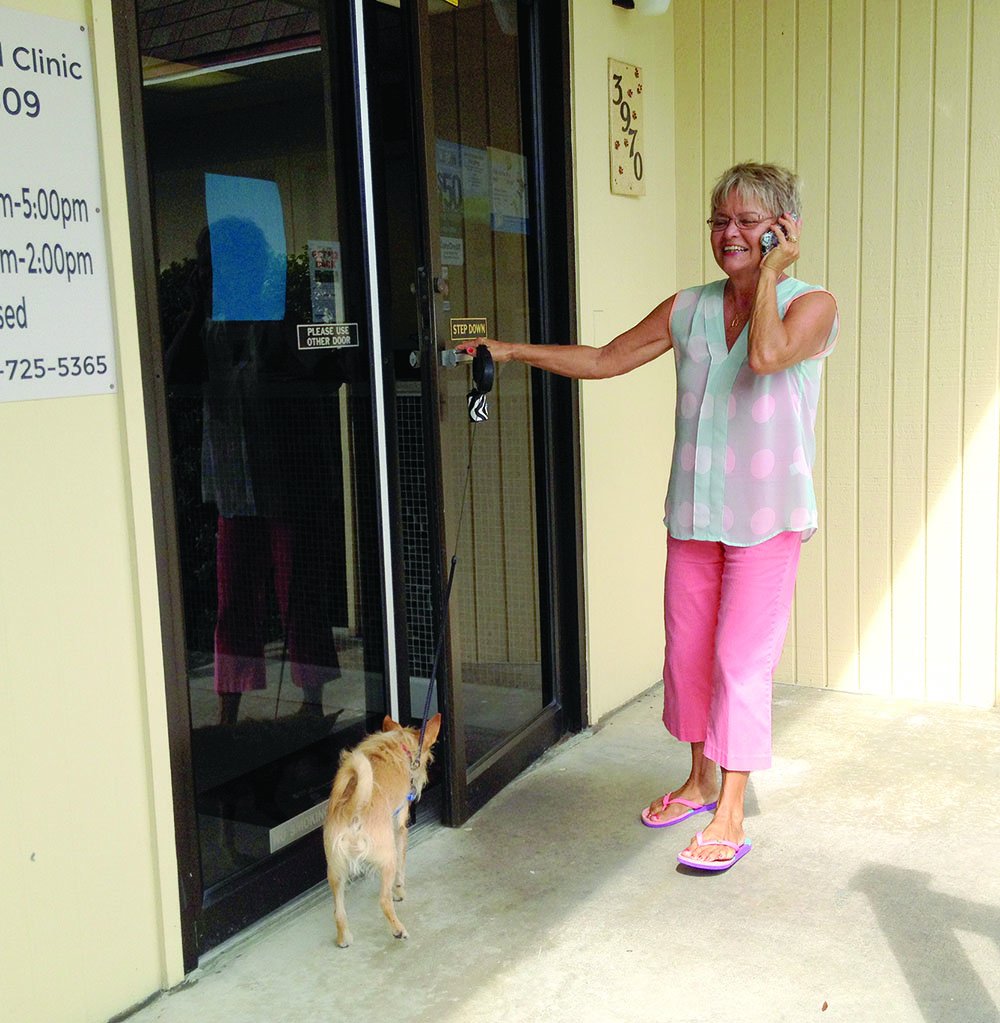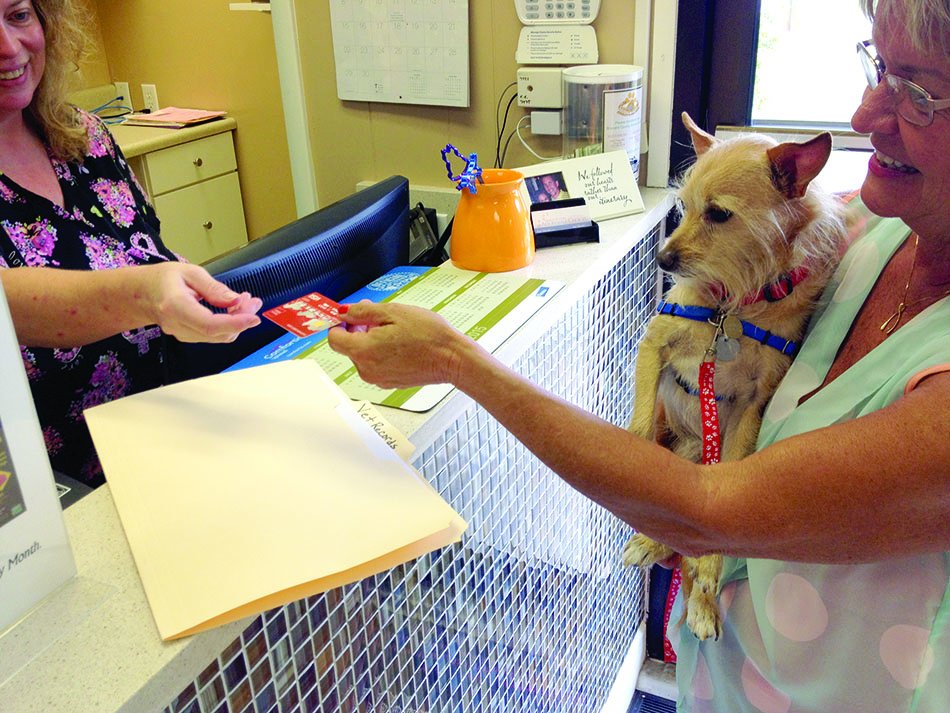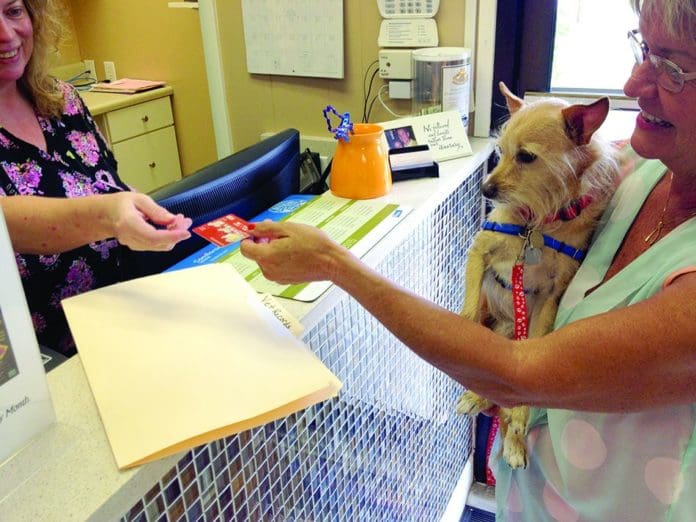[Updated August 24, 2018]
Making a grand entrance is something celebrities enjoy. There is a time and a place for this, however, and entering a veterinary clinic with your dog is not it! Unfortunately, a grandly bad entrance into vet clinics is very common, with dogs pulling and lunging at the end of tight leashes, perhaps barking or growling at the other dogs already present in the waiting area, while their people are hard-pressed to simultaneously control them, check in with the front-counter staff, and find a place to sit.
Does this sound familiar? Does it describe you and your dog? You may find some relief in knowing that you’re not alone. But it absolutely does not have to be this way! Here are some simple tips to help you and your dog enter a veterinary clinic with ease.

1. Have a Plan.
Thinking about and planning for every aspect of your and your dog’s vet visit can lower stress for you and your dog. Things to consider:
-
Your appointment time. If your dog becomes stressed and hard to manage around other dogs, schedule your appointment for the first thing in the morning or the first appointment after lunch. This way you are less likely to encounter an entire lobby full of dogs.

-
Transporting your dog. While riding in a crate is the safest option for most dogs, car safety harnesses provide another good option. The two most important things to consider are your dog’s safety and stress level. Each dog is an individual and it is up to you to choose the safest and least stressful means of transporting your dog in your car. If your dog becomes nervous during car rides, please consider consulting a professional behavior consultant for ways to help him become more comfortable and even love riding in a car.
-
Enough time for travel, potential delays, and pre-entrance pottying. Getting stressed (or yelling or swearing) about traffic delays or detours is a great way to make your dog tense and anxious before you even arrive. Give yourself more than enough time to arrive early for your appointment. Get yourself organized, get out of the car in a relaxed fashion, and allow your dog to walk around and even urinate if there is a safe space for this. Your dog will be far more relaxed inside if she has an empty bladder!
-
The parking situation. If your dog is not used to traffic, parking near a busy road may add to her stress. If possible, choose a more secluded parking spot.
-
Payment method. While this may not seem to fit in the category of “entering a vet clinic,” it’s important to consider ahead of time. After the doctor has completed his exam, you and your dog will be ushered to a checkout area. Considering what your dog may have experienced during the visit, she may be ready to leave and relentlessly pull toward the exit door. Why then, do we humans tend to make this one of the longest portions of the visit? “Hmm, should I pay with a check? No, maybe a credit card . . . but, which one? Do you take Discover?” Plan ahead by asking for an estimate of services (and which credit cards they accept) when you make the appointment, and have that card, or cash, or a partially filled-out check at the ready. In addition, it can be helpful to excuse yourself and your dog from the building immediately following the exam. Allow your dog to urinate and then place him/her safely in your properly ventilated car while you return to pay. (Please do this only if you know your dog can remain in your car for a few minutes safely and with minimal stress.)
2. Be Prepared to handle your dog thoughtfully throughout the visit.
Ensure that you have everything you and your dog will need to be successful.
-
Bring reinforcements. How will you communicate with your dog and let her know when she’s doing the right thing? Bring high value food or treats to reinforce your dog’s good behavior – unless you have been specifically instructed not to feed your dog due to a pending surgery or procedure. (In this case, bring a couple of your dog’s favorite toys!) A visit to the vet is a stressful experience for your dog and she will need lots of feedback from you about what she is doing right. Reinforcing good behavior with things she enjoys will increase those good behaviors in this and other settings.
-
Bring the right collar and leash. How will you keep your dog safe and close to you? Never use a retractable leash when taking your dog to the vet (we recommend never using them at all, but that’s another article). It’s harder to control a dog on a retractable leash, especially if you need to quickly pull your dog toward you and away from, say, another dog in the waiting area who suddenly erupts aggressively. Bring your dog to the vet wearing a flat buckle collar (or limited-slip or martingale collar) and/or a properly fitted harness, attached with a 4-6 foot leash. Keeping a short leash will help your dog close to you and focused on you.
-
If you are seeing a new vet or a specialist, bring your dog’s previous health records. This will guarantee that your dog will receive exactly what is needed for her health and what is required by your state law. This will also help your appointment run more smoothly and efficiently, which makes certain that your dog spends as little time in the exam room as necessary. These are all good things when trying to eliminate as much stress as possible for both of you.
3. Stay Positive to condition your dog to love going to the vet.
How do you like to be treated by others when you are worried and anxious? I’ll bet you respond much better to a kind word or a gentle touch than being ordered around by cranky healthcare workers or neglected by absent-minded ones. Keep this in mind while entering the clinic with your dog and it will help immensely!
Also, consider this: As soon as you walk into that lobby together, you become the only familiar piece in a very uncertain and scary puzzle for your dog. She will need you for comfort and reassurance. Be kind in your words and actions. Raising your voice, scolding, leash jerking, and forceful handling are all unnecessary and extremely counterproductive when communicating with our dogs – especially during a heightened time of stress and anxiety.
Will your dog follow your cues? Enter the building with a smile and confidence that this will be a good visit. Watch your dog and reinforce her when she focuses on you. Be present with her to show her that this is a positive experience and she will be just fine.

What if you mess up? If your dog jumps on another client or whines during your wait in the lobby, simply consider it information and make a mental note to work on that behavior through training. In the moment, redirect your dog and give her something appropriate to do – and then reinforce her for doing it. Stay positive and know that this is a process. If you aren’t sure where to start with your dog’s unwanted behavior at the veterinary clinic, contact a certified and trained professional who can assist you with your specific needs.
By following these simple steps you are well on your way to creating a more pleasant and productive experience in your vet’s office.





